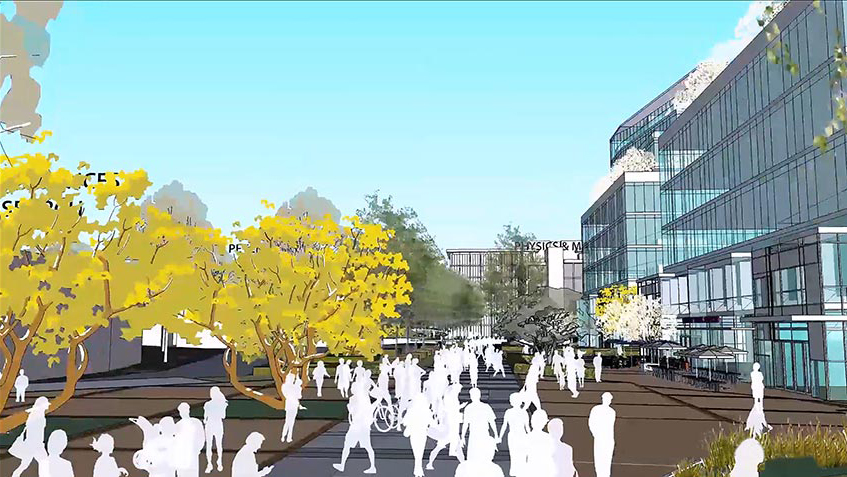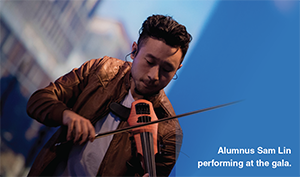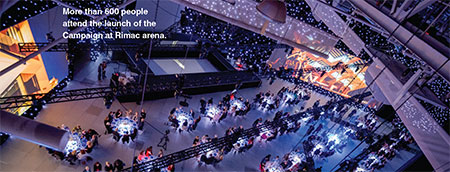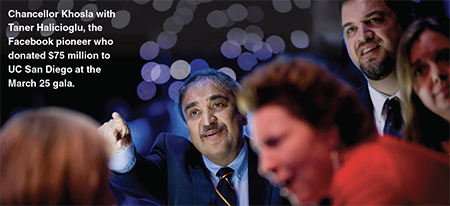By Jennifer Davies

The vision for UC San Diego is grand and unconventional. You might even say it’s nontraditional. In fact, that is exactly how Chancellor Pradeep K. Khosla describes UC San Diego’s future and past.
“What people forget is UC San Diego was literally created as an experimental campus,” Khosla said. “We were going to be a campus that would experiment with tradition. We were going to do things differently.”
It is this unorthodox route—which has focused on cutting-edge research and new approaches to education—that has led UC San Diego down such a successful path, allowing the university to achieve unparalleled success in a relatively short amount of time, Khosla said.
“Today, UC San Diego is recognized as one of the top 15 research universities in the world,” he said. “We have achieved this because we did not follow the traditional path. We followed the nontraditional path of doing things differently and doing things faster and better,” Khosla added.
Khosla hopes to continue and expand on this thinking-outside-of-the-box approach in all aspects of the university’s mission, from its students—undergrads and graduate students—to its faculty, research initiatives, and physical campus. To make that happen, UC San Diego recently launched an ambitious campaign to raise the $2 billion needed to make that far-reaching vision a reality.
 Fittingly, the theme is Continue the Nontradition, which the university unveiled March 25 to celebrate the launch of the public phase of the Campaign for UC San Diego. The unique event showcased the most compelling innovations generated by UC San Diego faculty—from robotics to virtual reality—and featured performances by noted alumni, including Grammy-nominated jazz bassist Nathan East.
Fittingly, the theme is Continue the Nontradition, which the university unveiled March 25 to celebrate the launch of the public phase of the Campaign for UC San Diego. The unique event showcased the most compelling innovations generated by UC San Diego faculty—from robotics to virtual reality—and featured performances by noted alumni, including Grammy-nominated jazz bassist Nathan East.
“More than 600 people showed up,” Khosla said. “That showed the support of the community and our alumni.”
The Campaign for UC San Diego has three priorities: sparking innovation and research, enhancing the student experience, and enriching the campus community. Khosla said each is important in its own right, but they are also interconnected with each other and the larger goals of the university.
“I’m firing on every cylinder,” Khosla said. “I’m focusing on the student experience. I’m focusing on graduation rates. I’m focusing on building infrastructure. I’m focusing on a new vision for the campus. If there’s one thing I’m excited about, it’s being Chancellor of this great institution because it allows me to do all these things.”
Fueling the Future
The ability to dream big and deliver on those dreams will not be easy or inexpensive. Underscoring the need for additional funding sources is the fact that UC San Diego receives only 7 percent of its total revenue from the state of California.
 “The state has been divesting from the UC system for many years now,” Khosla said. “Not only that, but all of our other sources of revenue are either being closed off or are going to become nonexistent very soon. A campus the size and stature of UC San Diego needs philanthropic support to reach its goals.”
“The state has been divesting from the UC system for many years now,” Khosla said. “Not only that, but all of our other sources of revenue are either being closed off or are going to become nonexistent very soon. A campus the size and stature of UC San Diego needs philanthropic support to reach its goals.”
Because of that, UC San Diego is relying on the Campaign to fund everything from scholarships for low-income students to helping finance additional campus housing and new educational facilities as well as make next-generation research possible.
“This Campaign is all about generating additional resources to invest back in our campus, in our students, in our faculty, and in our staff so that we can maintain the stature that we’ve achieved in the last 56 years,” Khosla said.
Sparking Research and Innovation
The Campaign launch started out with a bang with the announcement that Taner Halicioglu, a UC San Diego computer science alum and Facebook’s first full-time hire, had pledged $75 million to establish the Halicioglu Institute for Data Science. The goal of the new institute is to promote a cross-disciplinary approach to data science to ensure it supports a variety of other fields.
Khosla said gifts like these will be necessary to ensure UC San Diego can deliver on its promise to continue to break barriers and new ground.
“Sparking research and innovation is about creating endowed professorships and graduate fellowships to become competitive, and it is also building new programs that are going to define the future,” he said. “When new areas get created, it’s because of the cutting-edge work of some faculty. I want to be right there, identifying these people and bringing them to UC San Diego, nurturing and supporting them so UC San Diego becomes the defining organization for these areas.”
For Khosla, the proposed Halicioglu Institute for Data Science is just the first of many areas that UC San Diego must invest in to keep the university at the forefront of innovation and continue its life-changing work in such critical areas as personalized medicine, neuroscience, educational disparity, and climate change.
 Again, he said, the campus has a history of not only groundbreaking research, but developing and defining new areas of study. He pointed to the fact that UC San Diego was the first to create a Department of Cognitive Science—now a staple at most campuses. Khosla wants to continue that tradition— or, rather, nontradition.
Again, he said, the campus has a history of not only groundbreaking research, but developing and defining new areas of study. He pointed to the fact that UC San Diego was the first to create a Department of Cognitive Science—now a staple at most campuses. Khosla wants to continue that tradition— or, rather, nontradition.
“I think we are one of the first institutions to establish a very large data sciences institute,” he said. “We are the leading institution in microbiome research. Our strengths in climate science and Scripps Institution of Oceanography put us at the forefront of understanding the interaction of oceans and human health. I can go down the list of all our great capabilities and create combinations of these capabilities to define new areas
Enhancing the Student Experience
Yet another component to achieving these goals is to increase UC San Diego’s reputation when it comes to student experience, Khosla said.
“I’ve told people that the difference between a very good university and a great university is the focus on undergraduate education and the undergraduate experience. One of the goals of this Campaign is to go from very good to great by putting more of a focus on the undergraduate experience than we have in the past,” he said.
Khosla defined student experience “as anything and everything that has to do with the first day you walk on to campus to the day you graduate.”
While that is a broad definition, Khosla said a key goal of his is to expand scholarships to ensure UC San Diego continues to attract and serve a student body that is “competitive, inclusive, and mirrors California’s diversity.”
Currently, a third of all UC San Diego undergraduates are on Pell Grants and nearly half are first-generation students.
“These types of students benefit from supplemental support like academic enhancement services that we should be providing them to guarantee their success,” Khosla said. “We need more scholarships for students who are academically high achievers but also for students who are coming from lower-income backgrounds so that they can go through college without borrowing too much money.”
It also means building more housing and establishing new colleges to provide students with affordable housing and create a greater connection to the campus.
“We are building undergraduate housing on campus so I can guarantee four years of campus housing to anyone who wants it,” Khosla said. “We are also building new colleges so that our students have the small college experience within a larger campus. That was the original goal, but we have outgrown our infrastructure.”
Enriching the Campus Community
In many ways, the student experience is interwoven with another funding priority, which is to enrich the campus community.
The goal is for UC San Diego to become a “true living/learning campus”—one that works not just for students, faculty, and staff, but also the community. To that end, the university has big plans to build a variety of state-of-the-art buildings that support social sciences, arts and humanities, biological and physical sciences, marine sciences, and engineering. The goal of these new buildings is to foster cross-department collaboration and provide specialized learning and teaching environments that offer hands-on education opportunities.
Khosla said the student population is going to grow dramatically during the next five years and, currently, UC San Diego does not have the facilities to keep up with that projected growth.
 “We don’t have enough teaching facilities. We don’t have enough faculty. If we do hire faculty, then we don’t have enough research facilities. We need to build better infrastructure.”
“We don’t have enough teaching facilities. We don’t have enough faculty. If we do hire faculty, then we don’t have enough research facilities. We need to build better infrastructure.”
The need, combined with the vision for UC San Diego’s future, adds up to a distinctly different look and feel for the campus in the not-too-distant future.
“If you were to go to sleep today and wake up five years from now, you would not recognize this campus,” Khosla said. “In that time, we would have built close to $2 billion in infrastructure. We would have built brand new academic buildings. We would have built two new colleges and added 10,000 more beds. People would come to campus not just for our educational programs, but also because we have great theater and great music auditoriums and great restaurants. The campus will feel and look like a vibrant city or town.”
A main driver of this new look and feel will be the UC San Diego Blue Line Trolley, which is set to open in 2021 and connect the campus with the larger community, running all the way from San Ysidro at the border to the La Jolla campus.
Extending to the Community
When that infrastructure is in place, UC San Diego plans to move beyond its campus and offer educational opportunities in even more progressive ways. Yes, the UC San Diego campus will be transformed by the dynamic changes, but it’s no island. Key to creating this new connection with the community is UC San Diego’s proposed downtown facility, which Extension will be in charge of developing and managing. Khosla said the proposed 66,000-square-foot building at Park Avenue and Market Street will be critical to fostering a more accessible campus that is better connected to downtown and the diverse urban neighborhoods nearby, allowing the campus to engage with the broader community in more meaningful ways.
It will be the city’s first four-year university presence in downtown, which is fast becoming home to many ambitious startups.
“When we build more housing, more infrastructure, more buildings, we need to make this a living and learning community because the light rail is coming to town, and the light rail fundamentally changes the way we look at our campus,” Khosla said. “The outside comes in and the inside goes out. That changes the dynamic of our interaction with the broader community.”
Mary Walshok, associate vice chancellor of public programs and the dean of UC San Diego Extension, said Extension is ready to help deliver on the university’s goals of developing and supporting a diverse student population as well as contributing to the civic and cultural life of the larger region. The downtown location will expand Extension’s ability to offer innovative and effective pre-college programs that help students properly prepare for the rigors of college life. The facility, which is expected to open in 2021, will also be home to business incubation and entrepreneurship resources and offer a venue for arts events and exhibits to showcase the university’s and the larger community’s cultural offerings. In addition, it will be a hub for civic engagement and offer courses, workshops, and seminars that are relevant to the urban core’s growing workforce.
“This new facility will allow UC San Diego to be embedded in the community in a way it hasn’t been before,” Walshok said. “It is just one of the many ways that Extension is helping to deliver on the promise of a research university in the 21st century.”
With Extension’s long-standing relationships with business and civic leaders and its innovative and wide range of education and training programs, Khosla agreed that Extension is uniquely positioned to help UC San Diego reach its goal of connecting with the community in a more meaningful way.
“We want to further strengthen the relationships between the community and the campus and use Extension, as the word denotes, as our arms and legs to extend ourselves beyond this campus and into the broader community,” Khosla said. “This is exactly why the new building downtown plays a very significant role. Extension, in my mind, is a two-way bond between us and the community. Extension is the glue that helps us achieve that.”